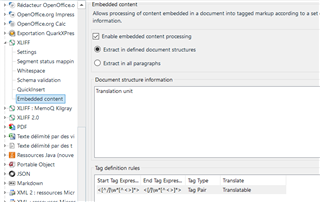Hi Community,
I would like to clean up an XLF file and help the segmentation a bit, as there are multiple sentences within the translation units, all added to the same segment in Studio.
I would like to amend the parser settings so the <g> tags are excluded from the segments.
Here is a sample:
<g id="rG3HWrhBpwgG-Jg0" ctype="x-html-P"> <g id="PfWMnh-oqz10lr2y" ctype="x-html-SPAN" xhtml:style="color: rgb(0, 0, 0);">Welcome to our Cyber Security Week training course! This is your opportunity to learn how you can protect yourself wherever you are, and to refresh your understanding of cyber security topics such as <g id="soLH-J4KMcUGcmx9" ctype="x-html-STRONG">Phishing</g>, <g id="-4yEvEpngeUlciMV" ctype="x-html-STRONG">Social Engineering</g> and <g id="vVmwpPgsr-qHfHcC" ctype="x-html-STRONG">Information Classification</g>.</g></g> </source> </trans-unit> </body> </file> <file original="l9vjMq2X-3LkpMPjDt8vFqEMhDeBLuGA" datatype="plaintext" source-language="en-GB"> <body> <trans-unit id="title"> <source>Secure Working</source> </trans-unit><trans-unit id="items|1|items|0|paragraph"> <source> <g id="qv21OEzOZzzf7Wm1" ctype="x-html-P"> <g id="n3JOa20jwbUvaWml" ctype="x-html-SPAN" xhtml:style="font-size: 18px; color: rgb(255, 255, 255);">Cyber criminals are relentless in their attacks and use various tactics to try and steal our company and personal data, whether we’re working from home, in the office, in a factory or travelling. Below are some key guidelines that will help to keep you safe against cyber-crime. </g> </g> </g> </source> </trans-unit>
I added these:
<[^/]\w*[^<>]*>
<[/]\w*[^<>]*>
These are my settings:

(Segmentation hint: exclude)
But it's not working, the text is not broken after the tag pair.
Can you please help what I'm doing wrong?
I also tried creating a custom file type (based on XML v 1.3.0.0) where the segmentation is good but the source gets overwritten with the target in the end, and I'm not sure what to do.
Thank you!
Greta
Generated Image Alt-Text
[edited by: Trados AI at 4:49 AM (GMT 0) on 5 Mar 2024]


 Translate
Translate


